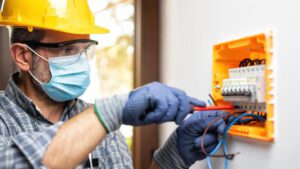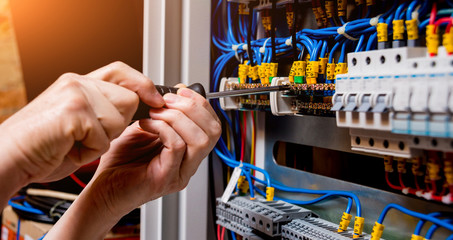Electrician Boca Raton installs, repairs, and maintains buildings’ electrical power, communications, lighting, and control systems. They also ensure that all electrical work is up to code.

People interested in becoming electricians need normal color vision to work with wires and the physical strength to be on their feet all day. They often follow a trade school program or a union apprenticeship to gain the necessary skills.
Electricians use their skills to plan, install and maintain electrical wiring systems across a variety of environments. This includes residential homes and commercial buildings, industrial machinery and equipment, as well as outdoor spaces. Without their skills, everyday Australians wouldn’t have access to the lights, televisions, appliances and equipment that make modern life possible.
Depending on their specialisation, electricians may also be responsible for installing lighting, power outlets, conduits, cable trays, ladder racks and emergency lighting. They may also be tasked with reading blueprints and technical drawings to determine the appropriate layout for electrical equipment.
Electricians also work with contractors to prepare and execute new electrical installation projects. This involves completing and recording inspections, as well as communicating with architects, electrical engineers and building contractors to ensure that all plans are followed and executed properly.
As technology advances, electricians must continuously update their knowledge to remain relevant in the field. This involves keeping up with yearly changes to regulations and learning about new products, technologies and tools that can help them perform their job more effectively and safely.
In addition to training and certification, electricians are required to adhere to stringent safety standards when working on live electricity lines and power systems. They are trained to follow best practices, as well as comply with all local, state and federal safety guidelines. They also receive regular on-the-job training from experienced journeymen, which helps them develop the necessary skills to work independently.
A career as an electrician is a good choice for anyone looking to avoid the steep climb of a traditional university education. Instead of incurring large student debt, many electricians choose to pursue vocational and apprenticeship programs that provide on-the-job training and the opportunity to earn while they learn.
There are several different types of electricians, including service, construction and linemen. Service electricians troubleshoot wiring problems, repair circuits and replace light fixtures. Construction electricians primarily focus on large projects, such as rewiring entire buildings or adding new components to existing structures. Linemen work on high-voltage utility distribution and transmission lines, climbing to the top of power poles or using lift buckets to install, maintain and repair these important infrastructures.
Repair
Our homes and businesses rely on electricity to function. We need it to turn on lights, microwave food, clean our clothes, and use electronic devices. When it breaks down, it can be very inconvenient. Skilled electricians diagnose problems and repair them quickly to get your life back on track as soon as possible.
A common repair involves fixing frayed or faulty wiring. This is a dangerous job, and one that should only be performed by licensed professionals. Faulty wiring can lead to fires, shocks, and electrocution.
An electrician can also install new outlets for home improvement projects. If you want to add a ceiling fan in your living room, for example, it will require complex wiring. An experienced technician can run the wires, patch the drywall, and paint over it to hide the work. This will make the room look much more finished than a DIY project would.
Electricians also can repair outdoor lighting and power lines. These are often buried underground, so it’s difficult for homeowners to fix them themselves. The electrician will inspect the lines to ensure they are safe and in good condition. If they’re not, the electrician will dig up the old wires and replace them with new ones.
Electrical contractors can also assist with major electrical projects, such as building new homes or commercial structures. They’ll install the wiring and other components, and test them to ensure they are working properly. They may also write up a blueprint or schematic of the wiring to help other workers understand how it works.
The type of work an electrician does depends on whether they specialize in construction or maintenance. Those who specialize in construction primarily build wiring systems in houses, apartments, and other buildings. They can also install the lighting and other fixtures that go into these spaces. Other types of electricians focus on maintenance and repair. They visit residential and commercial properties to monitor the status of the electrical system and perform any necessary repairs. These can include replacing circuit breakers, fuses, and switches. They might also inspect and maintain the electrical equipment and machinery in a factory or other business.
Maintenance
Every home, office, factory and other facility has an electrical power, communications, lighting and control system that requires regular maintenance. Licensed electricians ensure that these systems remain in good working condition and help to reduce the risk of fires, shocks and other electrical failures. They perform inspections of wiring, outlets and switches to identify potential problems and make repairs as needed. Electricians also install electrical upgrades and updates to improve the efficiency of lighting, appliances and other electrical devices.
Electricians are often called upon to respond to emergencies and address urgent repairs at all hours of the day, including weekends and holidays. This can be a challenging aspect of the job, but it is one that many experienced electricians find rewarding. Some electricians choose to become independent contractors, allowing them more flexibility in how and where they work.
A successful career as an electrician requires excellent critical thinking and problem-solving skills. It is not uncommon for these professionals to need to decipher complex technical and wiring diagrams, including blueprints. Strong color vision is also important, as electricians must be able to identify wires by their specific colors and special markings.
Depending on the type of electrical maintenance needed, an electrician may use a variety of hand tools to complete the task. These include pliers, wire cutters, screwdrivers, knives and conduit benders. They may also need to inspect a facility’s backup generator, transformers and other electrical components with specialized testing equipment.
The most common type of electrical maintenance involves assessing the current condition of wiring, outlets and surge protectors. Electricians will check their work with a voltage meter and test components for proper functioning. In addition, they will replace light bulbs as necessary and recommend energy-efficient upgrades to lower utility bills. Other types of maintenance involve evaluating the overall electrical load of a facility and installing new circuit breakers or surge protection as needed. This is particularly important if the facility is experiencing frequent overloading or has older equipment that is at greater risk for failure. These upgrades can be expensive, but they can also save money in the long run by reducing energy consumption and decreasing the chance of a catastrophic electrical outage.
Troubleshooting
A faulty electrical fixture, wiring or power source can lead to dangerous situations like electrical shock, fires and even explosions. This is why electricians are trained to troubleshoot electrical problems and determine their root causes. They also know how to install and repair electrical fixtures and wires properly, ensuring that they are up to code.
When an electrician visits your home to solve a problem, they will first take all the necessary precautions such as turning off the power source and using non-contact voltage testers and multimeters to make sure that the circuit is completely dead before working on it. They will then test each component of the circuit individually to isolate and identify the culprit. If possible, they will replace the faulty component with an identical one to ensure that the problem is not spread throughout the system.
Common electrical problems that an electrician may troubleshoot include flickering lights, electrical surges or power outages. Usually, these issues are the result of overloading the power source and require the help of a professional. If your house experiences frequent power outages, it could be due to a storm or downed lines that cut off your electricity from the local utility company. It could also be a sign that your wiring or breaker box needs upgrading to meet the power demands of your household.
If you have experienced any of these issues, you can start by reducing the number of power-consuming appliances in your house and using lower settings on your light switches. If the issue persists, you should call an electrician to inspect your breaker box and wiring to ensure that they are up to code.
The critical thinking skills that an electrician must have to troubleshoot are tested when they use a variety of specialized equipment such as ohm meters, voltmeters and ammeters. They must also possess physical stamina and strength to lift heavy boxes, work with pliers and drills, and run a wide variety of wires. They also must be able to read and understand technical information on electrical components, as well as write down notes and diagrams of their findings.

